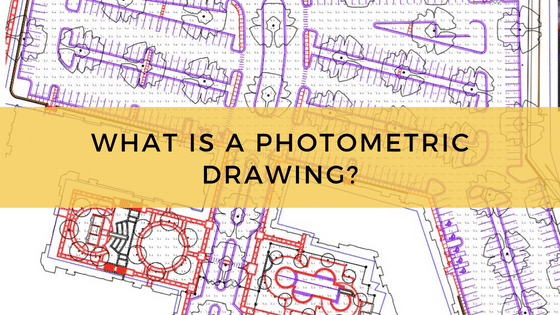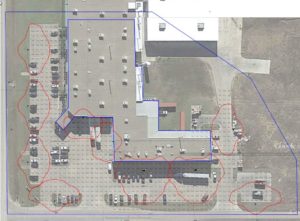
A photometric drawing (also called a photometric lighting plan or design) is essential for any lighting design as it allows lighting professionals to visualize a system before it is installed. Photometric plans are often used in tandem with an AGi32 calculation tool for accurately predicting the photometric design. This is essential before breaking ground on a lighting project, for several reasons. The lighting industry uses photometric plans to arrange fixtures and ensure output intensity is distributed evenly.
There’s a lot of data included with every photometric study, and this data can be presented as raw numerical values or as a visual example. To generate this photometric report, lighting specialists use software such as AGi32, which is designed for the task.
How Do Lighting Designers Use Photometric Software?
Every light comes with its own photometric properties. Some lights emit directionally, while others radiate in every direction. Some lighting fixtures spread illumination further than others. This data is collated and provided to lighting professionals by the manufacturer.
During a photometric analysis, the lighting designer arranges each fixture inside the software, placing them in a rendered version of the client’s property. Fixture-specific photometric data is plugged in for each fixture and the software does the heavy number crunching. This includes taking measurements of lighting levels at every point in space.
What Does a Photometric Plan Look Like?

It’s more common, though, for lighting professionals to visualize the system using photometric software. Some professionals will produce a 3D rendering of the client’s property and simulate the distribution of light as the human eye would see it.
Photometric software can also generate wireframes or heat maps to detect areas that are receiving too much illumination and spaces that are too dark.
When is a Photometric Lighting Design Needed?
In most cases, property owners are not required to get a photometric analysis before starting a commercial lighting project, but it’s strongly recommended for several reasons, including:
- Commercial lighting systems must meet lighting safety codes – Commercial properties must maintain a minimum lighting threshold if they operate during evening or nighttime hours. Failure to do so could expose the property owner to legal action if an injury occurs due to poor lighting. Photometric analysis ensures your property meets those lighting codes without anything left up to chance.
- They also have to follow light pollution regulations – On your property, you’ll want to optimize your system’s output. Off your property, you’ll be required to minimize any lighting trespass or pollution. In other words, keep the light you produce on your property. There are additional lighting codes that require this and violating those codes can result in hefty fines.
- You’ll get maximum return on your investment with a photometric plan – Ideally, your lighting system will provide all the illumination you need with as few fixtures as possible. Too many fixtures are a waste and too much light is both uncomfortable and wasteful.
Photometric plans allow designers to experiment with a variety of system layouts and fixture options. The goal is to find the best combination of layout and lamp to meet all project requirements. This degree of optimization is impossible without photometric software.
What Information Can a Photometric Analysis Provide?
A photometric analysis can answer a lot of questions about your lighting system’s projected performance. For instance, a photometric analysis can provide insight into the following:
- The angle and distance of light emission – Using manufacturer data, typically IES files, photometric software can measure the angle each fixture is emitting at, and how far that light is reaching. This is critical for determining if light pollution is a problem.
- The amount of light at every spot – Lighting intensity, as detected by the human eye, is measured in lumens. Photometric software prefers lumens when calculating how much light is reaching every part of the environment.
That means photometric software can visualize how intense the light will be perceived at every point. This ensures the system meets all visibility, safety, and security requirements. It also helps designers spot overly intense or underlit areas. - Footcandle levels – Some projects require minimal footcandle levels, and a proper design plan is essential for determining the ideal footcandle calculation. This ensures the area is evenly lit with the proper intensity.
- The ideal system layout – The goal of most commercial lighting systems is to produce enough illumination and even illumination. Photometric software makes it easy for designers to achieve both. The software responds to changes in fixture arrangement, so the designer can play around with fixture positioning to create an optimal system layout.
- Which fixtures will work best – Photometric analysis can be used with nearly every type of lamp in existence, as long as there is data on it. The designer can cycle through all of the available luminaires and pick one that provides the best performance and appearance.
With all of these factors accounted for, construction on your lighting project can begin with a clear plan in place. This will save your build teams some valuable time, which saves you money.
Photometric drawings are vital for ensuring lighting plans will provide the intended illumination. They are useful for exterior lighting systems, including solutions for parking lots, commercial campuses and parks. Be sure the company you work with will follow strict lighting codes and has extensive experience with photometric analysis to provide a clear picture of how your new lighting solution will look long before it becomes reality. At LED Spot, our basic photometric plans begin at a modest cost of $250, which is an affordable way to ensure your lighting project performs as intended.






